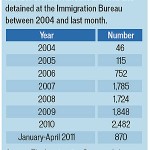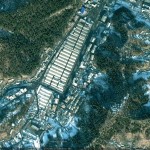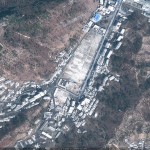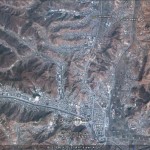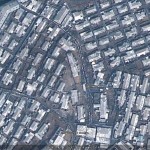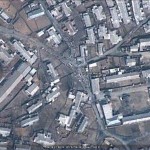According to the Hankyoreh:
China is stepping out into the Pacific through the gates of North Korea’s Rason Special District. North Korea, which has been declaring its aim of creating a “strong and prosperous nation by 2012,” is actively welcoming the move from China.
A number of sources, including officials with the Jilin Province government in China, reported that a groundbreaking ceremony is to be held on May 30 for a highway linking the North Korea cities of Wonjong and Rason, bordering directly on Quanhe in Hunchun, Jilin Province. A number of leaders from both countries are scheduled to attend the ceremony, which is to take place in Rason (Rajin-Sonbong), North Korea.
A Chinese official working on preparations for the project said in a recent interview with the Hankyoreh that the event would be “an occasion for declaring North Korea-China economic cooperation and North Korean openness to the world.” The official added that dozens of officials from the Chinese central government would be attending, including a number of leaders.
The construction effort is a signal announcing the opening of Rason and large-scale economic cooperation between North Korea and China. In addition to the groundbreaking ceremony for the highway, which is to be a major channel tying North Korea and China together economically, efforts to develop China’s Rajin Harbor and transport large amounts of coal through it are beginning in earnest.
The Rason development effort is taking place according to China’s “blueprints” in everything from the planning to investment and management. Local sources said that China and North Korea have already formed a special joint steering committee for the district, and that it has been decided that the chairman will be from China.
The Rason urban development plan jointly drafted by China and North Korea includes the development of international freight brokerage, export processing, and financial regions. According to a North Korean video, models for the plan include Dalian and Tianjin, which Kim Jong-il inspected in 2010 during a visit to China.
An official with the Yanji city government said, “North Korea is also aware that keeping its doors closed will only lead to death, but it is concerned that the regime will be destabilized if it opens up all at once, so it plans to first open up Rajin and develop it as a ‘test region.’”
“They are adopting the Chinese model, learning from China about legislation, taxes, and benefits to lure businesses,” the official added.
The effort is being pursued promptly, in contrast with previous North Korea-China economic efforts, which tended to amount to little more than words. The reason for this is that the central governments in Beijing and Pyonyang are directly taking care of economic cooperation through the medium of Rason’s development.
A Chinese government official reported that Chinese Minister of Commerce Chen Deming traveled to North Korea to sign a memorandum of understanding, and that China and North agreed on a plan for joint investment in and administration of Rason’s highway, port, and industrial park construction. The official added the Chinese Prime Minister Wen Jiabao personally signed policy documents upgrading Hunchun to a special economic district in line with the Rason development plans.
Meanwhile, North Korea formed an office in its central government to directly administer Rason Special City, replaced old officials who failed to make progress with Rason’s development over the years, and sent in young officials from the central government, including Rason Special City secretary Im Kyong-man, sources reported.
China needs the Rason development to ensure the success of its current national development plan for Changchun, Jilin, and the Tumen River basin, while North Korea decided to cooperate with China to address its economic problems and stabilize its succession framework. Analysts say North Korea hopes to tout successful development of Rason as an achievement of Kim Jong-un.
The development project is proceeding in a very specific and far-reaching way. “This is Korean land, but the industrial complex is being operated as Chinese and will hire North Korea workers to earn foreign currency” for North Korea, said an official with a Chinese company in charge of a large-scale construction effort in Rason.
The electricity shortage issue, which had previously been a major stumbling block to investment, has been resolved by China. A source in Hunchun said, “Plans are being examined to either send surplus power from Hunchun’s thermoelectric power plants to Rason, or for a company in Jilin Province to retrofit an old Soviet crude oil plant in the Sonbong region into a coal-burning power plant.”
Even Chinese officials have been astonished at the active measures from Pyongyang. A Rajin representatives’ office opened in downtown Yanji, the seat of the Yanbian Korean Autonomous Prefecture, is hard at work drawing in investment.
“If Chinese investors want to take a look at Rason, they can drive their cars in for themselves with an invitation from the Rajin representatives,” explained a source in Yanbian.
In the border city of Hunchun, money and people have begun shifting toward the North Korean side. Construction of 500 apartments for Chinese people working in Rason began in late March, according to officials at a construction company commissioned to carry out the project. Capital and labor investment for the Hunchun-Rason highway construction is coming entirely from China, and a number of the roughly 500 Chinese workers needed to begin have already arrived in Rason with six-month passes issued by North Korea. Large Chinese corporations such as Changli, Shangdi Guanquan Investment, and FAW are known to be undertaking investment in Rason.
According to the Korea Herald:
Despite its reputation as one of the most closed nations in the world, North Korea is, at least partly, opening up to market economy conventions, evident in its effort to cultivate its specially designated economic zone.
North Korea designated Raseon the country’s first free trade zone, as a “special city” in January 2010. The city, which borders both China and Russia, was dubbed a free trade zone along with nearby Sonbong in 1991, even though foreign investment never materialized.
In recent years, the North has tried to reinvigorate the trade zone, signing an accord with Russia to restore railways that could help rejuvenate the port there. Russia invested 140 million euro ($202 million) in the Rason project in late 2008.
In recent months, North Korea appears to have initiated a media campaign for Rason, beckoning foreign investors as Pyongyang struggles to resuscitate its moribund economy, according to informed sources and media reports.
According to a source familiar with North Korean affairs, the city has seen both new factories built and upgrades of previous ones.
A couple of large Chinese companies have also reportedly signed deals on either providing construction parts or investments in the region’s resources development.
Chinese commerce officials from the central government and the nearby Jilin Province have also reportedly held talks with their Pyongyang, Rason counterparts regarding such business transactions.
The city is also becoming more urbanized, according to sources. Apartments and road construction repairs are sprouting, while the number of daily logistics traffic across the nearby North Korea-Chinese border has nearly doubled to some 200 trucks in late April, compared to some 100 trucks just three months ago.
The North Korean leader Kim Jong-il recently traveled to the city, a move that analysts see as underlining the regime’s desire to promote the trade city to lure foreign investment.
The KCNA reported on April 22 that Kim visited the city’s Rajin Shipyard where he was briefed on different processes of shipbuilding. There he highlighted the importance of the shipbuilding industry and urged for the introduction of new production technology.
It was the first time that the North’s tightly controlled media reported the name of the shipyard and Kim’s visit there. Known as one of three major shipyards in North Korea, the Rajin Shipyard is believed to have built warships and submarines, according to sources in Seoul.
Increasing media reports from North Korea on Rason also seems to back claims that the country is putting its weight behind the city.
On April 19, the KCNA filed a profile report on Rason’s tourism industry, touting its historic relics, cultural facilities and fantastic seascape “and introducing tourist hot spots in and near the city.
In an earlier, March 30 report, the KCNA said that the city has adopted “a preferential tariff system” for foreign investors and traders.
“Choe Kwang-nam, an official in charge of economic cooperation of the Rason City People’s Committee, told the KCNA that the zone provides favorable business conditions to foreign investors through the preferential tariff system,” it said.
“Foreign investors and businesses are allowed to conduct diverse economic and trade activities and have a free choice of investment forms and business,” it quoted Choe as saying.
Read the full stories here:
N.Korea’s Rason Special District could open country to China
Hankyoreh
Park Min-hee
2011-5-4
Investment, projects seemingly brim in N. Korea border city
Korea Herald
2011-5-4

